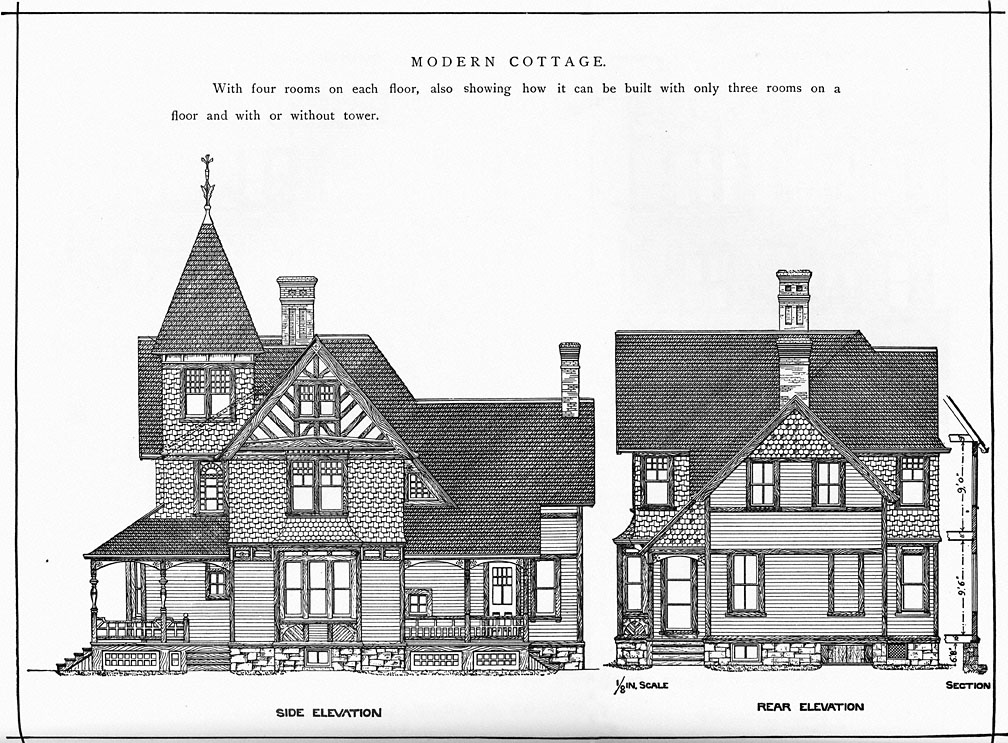- Catalog No. —
- Ov 728P168 1978
- Date —
- circa 1888
- Era —
- 1881-1920 (Industrialization and Progressive Reform)
- Themes —
- Architecture and Historic Preservation, Arts, Geography and Places
- Credits —
- Oregon Historical Society
- Regions —
- Southwest
- Author —
- Palliser, Palliser, & Co.
Cottage from Palliser's American Architecture
This design for a “modern cottage” was published in 1878 and again in 1887 by architects George and Charles Palliser of New York City. The plan was used about 1890 by the children of Thomas and Margaret Chavner to build a house in Gold Hill, Oregon.
When he was in middle age, adventurer and gold-seeker Thomas Chavner (b. 1814) made a modest financial success of a gold mine he operated at Gold Hill, located along the Rogue River east of Grants Pass. Thomas and his wife Margaret (1827-1880) had five children between 1862 and 1877, and Thomas apparently planned to build a large house for his growing family. Although Thomas died in 1888, his surviving children completed the construction. They used a design created by the well-known East Coast architect and publisher, Palliser, Palliser & Co. The Pallisers sold complete plans for a house, which could then be erected by a local builder. Some publishers of these house plan catalogs, known as pattern books, even arranged for the shipment of all or part of the required materials, such as the hardware, specially-cut and milled lumber, and decorative details, although this practice is not documented in Oregon at this time.
The Queen Anne was an architectural style well-suited to wooden buildings. It was characterized by asymmetry and by an emphasis on a wide variety of architectural detail in a single structure. Some of the variety was expressed in such architectural features as turrets, bay windows, balconies, porches, and fireplaces. Materials and textures could also be varied, with wood being used for shingles, shiplap siding, jigsawed brackets, columns, and spandrels; buildings might be clad in a mixture of wood, brick, and stone. Often described as the ultimate in “Victorian gingerbread,” Queen Anne-style houses displayed an exuberance that was made possible and affordable largely by new technologies for the rapid and easy milling of decorative woodwork.
Other late nineteenth-century architectural styles included the Gothic Revival, the Italianate (very popular in Oregon), the Second Empire, Eastlake, and Stick Style. Such stylistic classification is the province of the architectural branch of art history, and is very useful in connecting aspects of a building’s appearance with its period in time and with artistic expression in other fields, such as art, design (furniture, clothing, decorative arts), and literature. The Queen Anne and other Victorian-era styles for residential buildings are also associated with contemporary ideas about proper or desirable domestic life. House plans emphasized the family with a working husband, a wife at home, and several children and provision was often made, as in the plans for this “cottage,” for live-in servants. The plans allowed for a degree of separation between adults, children, and servants, a quality which perhaps made this house workable for the parentless Chavner family.
Written by Richard Engeman, © Oregon Historical Society, 2005.
